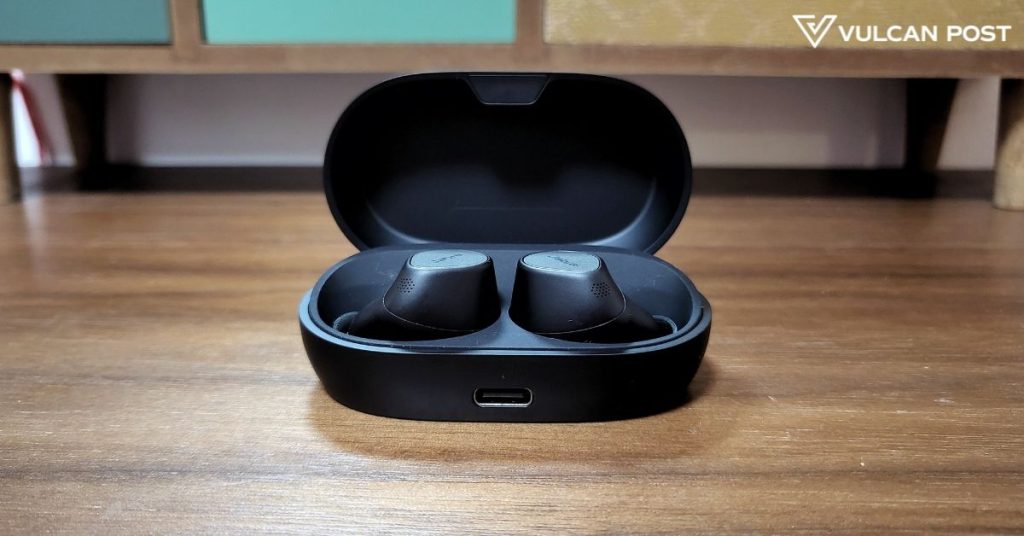Ever since testing out the Jabra Elite 3 a month ago, it’s been my go-to pair of true-wireless (TW) earbuds for music listening and show watching.
Though it was a budget pair from the brand with no ambient noise cancellation (ANC), its quality was good enough for me thanks to its clear audio and comfortable fit. So when I was given the chance to review the Jabra Elite 7 Pro, the brand’s most recent premium pair of TW earbuds, I didn’t hesitate.
First looks
Just like the previous models, the box came with the earbuds in Black, 3 different EarGels (earbud tips), a USB-A to USB-C charging cable, and a warning and declarations booklet. No manual is included, but you can find it in Jabra’s Sound+ app.
The shape of the Elite 7 Pro’s case is definitely the most distinct variation from its predecessors. While still pill-shaped, it now carries what Jabra calls an “ultra-compact design”, where the top and bottom half are of equal height, unlike the rest which were bottom heavy.
Honestly, the change in shape makes it harder to open it one handed—I’ve yet to find the right grip to do so—especially since it’s also slightly slippery.
Anyways, opening up its lid with 2 hands, you’ll find the buds housed comfortably in them, which had a similar size to the Jabra Elite 3. But apparently, they’re Jabra’s smallest earbuds so far, which I appreciated and didn’t feel the usual dull ache that I tend to get from wearing in-ear earbuds.
Charging was a breeze and took a rough 2 hours to bring it to a full charge that promises 8 hours of uninterrupted playtime. I’ve only had to bring the case’s battery up to 100% when I first received it, and I haven’t needed to do so after 5 days of usage (averaging about 4 hours/day).
Plus, the case can also charge wirelessly with Qi-enabled accessories, which are great if you’re on the go.
The earbuds had to of course be charged more often by being placed in the case. Jabra claims that it can fast-charge up to 1.2 hours of use in just 5 minutes. So far, I can’t prove them wrong.

On the inside
Plugging them in for the first time, I finally understood what my colleague meant when she said, “I’ve never heard every individual instrument in my music before,” about the Elite 75t.
Sound quality for the Elite 7 Pro had bright vocals, crisp highs, and deep basses, which was a pleasant listening experience for my usual pop music. Sure, you can customise your preferred EQ on the app or use Jarba’s presents, but these features were severely underutilised in my hands.

It’s mostly because I don’t demand much from my earbuds. So long as the audio sounded clear and well balanced, it was good enough for me.
While I’m someone who appreciates being aware of my surroundings and hence not a fan of ANC, my mind has since been changed by the Elite 7 Pro.
The thing is, my neighbours have been doing some heavy renovations, and the piercing noise from the drill was drowned out by the earbuds effortlessly. Just like the 85t, ANC is also adjustable with this model to fit the noise level of your surroundings.
More features I personally found advantageous with the Elite 7 Pro are its auto-pause abilities when one earbud is removed from the ear, and its mono-mode. It’s where I could use just one earbud to watch my videos while lying down on one side, while keeping the other side safe in its case.

Like its predecessors, the Elite 7 Pro also has physical buttons which I appreciate, as I wouldn’t accidentally trigger any functions when adjusting my hair.
New additions
Jabra has installed a bone conduction technology, called MultiSensor Voice, that supposedly cancels out wind for better call quality.
According to Jabra, bone conduction technology is used to transmit voice via the vibrations in your jawbone. The brand’s algorithm then uses the best combination of the bone conduction sensor and microphones to transmit the best call clarity.
When put to the test, my caller reported that they could hear me loud and clear, saying that I sounded very close to the mic. I wasn’t even speaking that loudly to begin with, and this is with my stove’s hood on full sucking power in the next room, and some music playing in the background.
I could also hear my caller very clearly, with no background noises from her side either. Hence, it’s safe to say that the MultiSensor Voice and noise-filtering tech for the call function did their jobs, and did them well.

Another new addition Jabra has added to its Elite 7 Pro earbuds is an IP57 rating. It’s a step up from the 85t’s IPX4 rating, where the X means, “untested for dust,” while the 4 means that they can withstand light splashing and sweat.
With this in mind, the Elite 7 Pro’s earbuds can survive submersion in 1-metre deep water for 30 minutes, and is nearly dust-tight. Obviously, I wasn’t brave enough to go swimming with them, but I did have a certain confidence running them under the tap to clean out dust.
The case isn’t waterproof though, so you’d have to dry the buds before putting them back in.
Verdict
In terms of my judgement on the buds’ sound quality, I’d say that Jabra’s Elite 7 Pro is on par with the 85t. The upgrades you do get from the Elite 7 Pro is the longer battery life, lighter and smaller earbuds, waterproofing, along with clearer call quality.
And for RM999, it’s a worthy deal to me when put against the 85t’s RM1,049.
If I had anything bad to say about the Elite 7 Pro, it would be the fact that I’m not able to fidget with the case by opening and closing its lid one-handed.
This obviously has nothing to do with the performance or quality of the earbuds whatsoever, and based on my experience thus far, I actually find little fault with the pair.
| Pros | Cons |
| Effective ANC | Difficult to open and close with one hand |
| Crisp, well balanced sound quality | Overwhelmingly customisable for an average user |
| Amazing call quality | |
| Comfortable fit | |
| Fully waterproof |
VP Verdict is a series where we personally try and test out products, services, fads, and apps. Want to suggest something else for us to try? Leave a comment here or send the suggestion to our Facebook page.
Also Read: 22 is not too young for life insurance—making sense of the confusing myths and facts

















